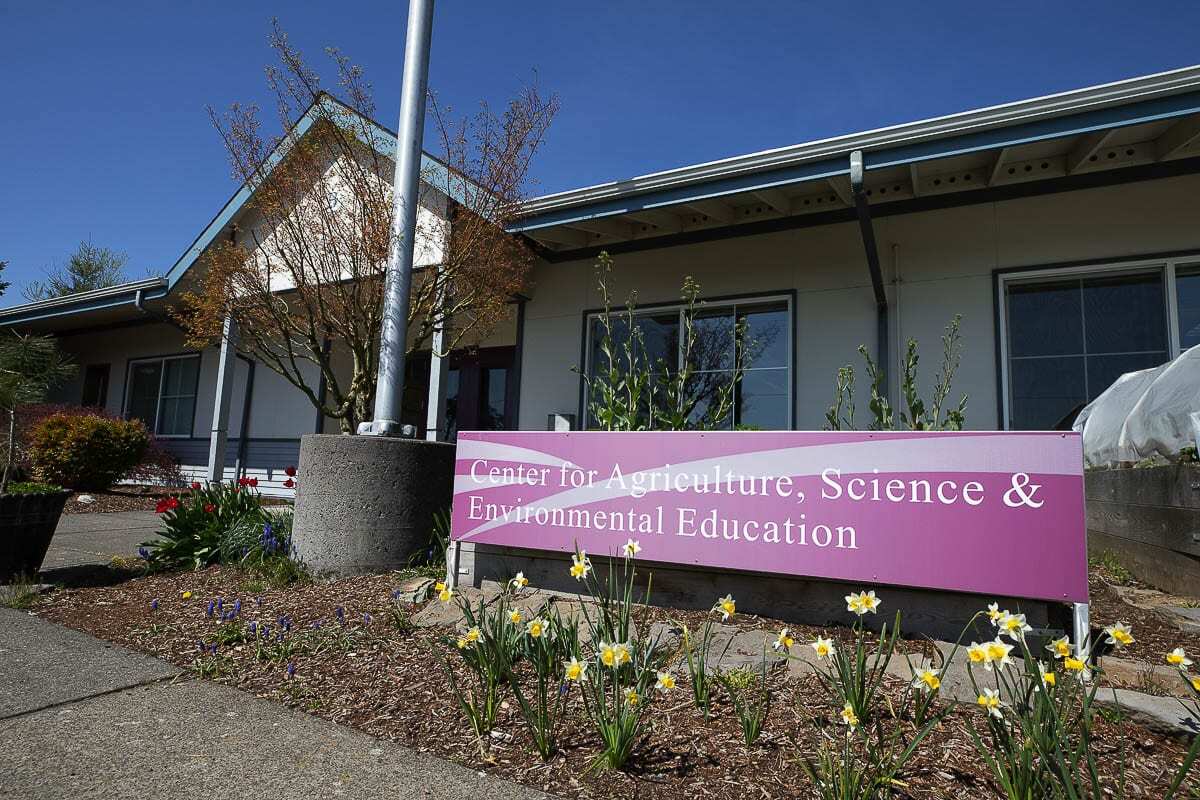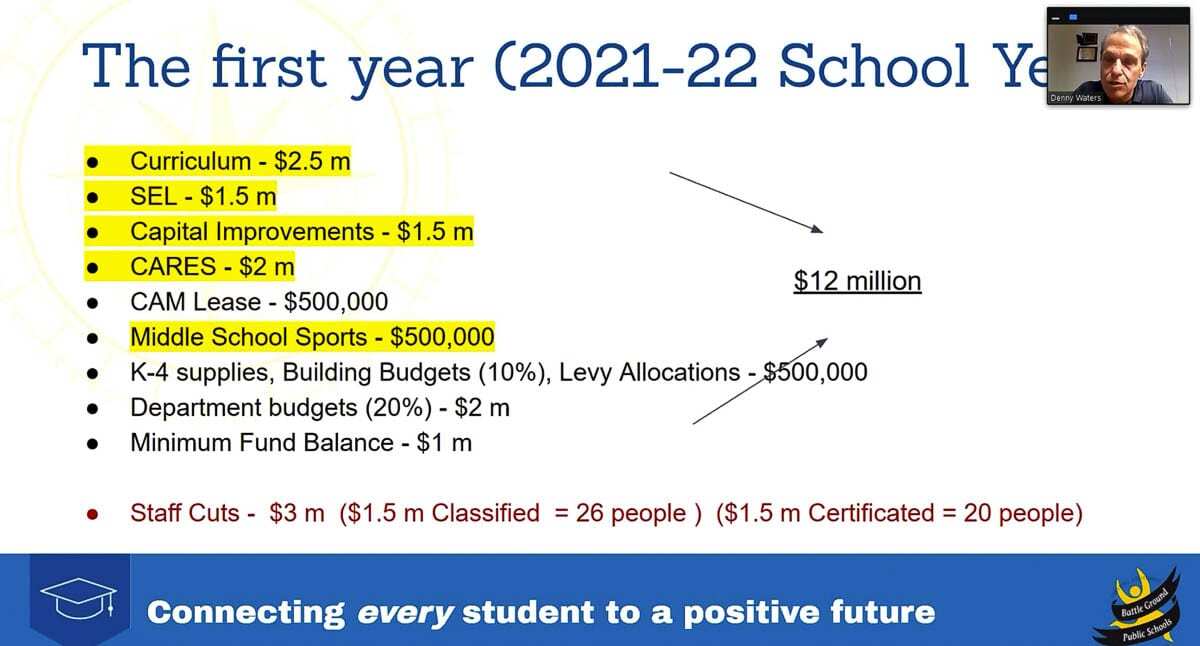Bypassing April, the levy could run again in August or November
BATTLE GROUND — Facing potentially crippling budget decisions, the Battle Ground School Board elected to hold off on putting their replacement four-year Educational Programs and Operations Levy in front of voters again in April.
The levy fell short during the Feb. 9 special election, with 52.43 percent of 20,441 voters saying no.

Battle Ground was among 46 districts in the state running at least one local levy this month, noted Deputy Superintendent Denny Waters during a presentation to the Board of Directors on Tuesday. All but four of those levies around the state passed.
“The other districts had very small amounts of students,” said Waters. “Most large districts pass their levies when they have the opportunity.”
Waters noted that all but six of the 295 school districts in the state currently have local levies, and all of those are much smaller districts than Battle Ground, which currently has approximately 12,500 students.
The February date was chosen because it historically has the highest passage rate for school levies, at more than 90 percent, said Waters. April is next highest, with August levies historically having the lowest passage rate.
“It is critical that we pass our next levy attempt. A double levy loss will set us back years,” Waters said at the end of a presentation on the budget impacts of a failed levy. “The most critical decision for the board is pick the best date that gives us the best chance we have to pass the levy.”
The board didn’t pick a date to re-run the levy, but rejected the April 27 special election.
“Basically, it’s a COVID decision for me,” said Vice President Troy McCoy. “I would rather wait, hopeful to get COVID in the rearview mirror, if that’s possible at all, and see what happens in the future, and getting more kids back in school.”
The April date would have also forced the district to largely put forward the same four-year replacement levy. A later date could afford the board the opportunity to make modifications based on further feedback.
“I do think we need to just pause for a bit and maybe listen to what the community’s telling us,” said Director Jackie Maddux. “So we do the best for our students in the long run.”
There’s also the issue of a change in board members and district leadership. Long-time Director Monty Anderson is stepping down after the Feb. 22 board meeting, and several others have indicated they may not run again in November, including Maddux who was named to replace Tina Lambert when she moved out of the district last year.
Current Superintendent Mark Ross is also retiring at the end of June, with Waters stepping up to replace him.
Worst-case scenarios
Battle Ground has suffered a double levy failure in the past. It happened in the 1980s and, most recently, in 2006.
“I was a student in the 80s, when we lost our buses and we lost middle school sports,” said Shelly Whitten, the district’s current assistant superintendent in charge of human resources. “And, as you know, neither one of those things exist in our district anymore, which means that we are at the mercy for transportation from someone else.”

Kevin Jolma, a long-time facilities manager with the district, recalled 2006, noting that one year he had $200,000 in his building maintenance budget cut for all of the district’s schools, in addition to losing 20 percent of his staff.
“It took a decade for me to recover from that,” said Jolma.
Waters also noted that the 2006 levy failure led to many of the current issues the district faces with out-of-date curriculum, and the expense they’ve faced in recent years trying to get caught up.
“When people always talk to us about our curriculum being in decline,” he said, “that’s one of the reasons right there.”
The district had been planning to bring middle school sports back this year, but pushed it back to next year due to pandemic-related issues and concern over the potential of a levy failure. It would return next year if the levy is approved but, Waters warned, even some high school sports could be on the chopping block if the levy isn’t approved.
That likely wouldn’t happen until the 2022-23 school year, when deeper budget cuts would be necessary without a new levy.
This coming year, the district would likely address the problems mainly through eliminating planned expenses.
That would include $2.5 million the district had planned to spend on new curriculum, $1.5 million for social-emotional learning (SEL) programs, $1.5 million in capital improvements, a 20 percent cut to department budgets, and the usage of a million dollars in ending fund balance. The cuts could also affect the CAM school building lease ($500,000), and reduce supplies and building budgets by 10 percent.
“I want to point out to everybody listening here that the curriculum, the SEL, the capital improvement, the middle school sports is all coming from fund balance,” said Waters. “And still, it really comes only to $12 million, which means that we need an additional $3 million of cuts. And the only thing left to cut is staff.”
Split evenly, that additional $3 million in staffing cuts would equate to 26 classified and 20 certificated staff next school year, said Waters. Some of that could be accomplished by leaving vacated positions unfilled, but some cuts would still likely be needed.
In the 2022-23 school year, Waters said, the district would likely need to find an additional $8 million in cuts. Since all the other programs and expenses would have already been eliminated, those cuts would likely be staff heavy, since personnel is 80 percent of the district’s budget.
That would amount to another 67 classified and 53 certificated staff, said Waters.
“Most likely these cuts would have to include district office staff, assistant principals, counselors, prevention intervention specialists, security, crossing guards, grounds and maintenance, high school athletics and activities,” he added.
All of that is focused only on the loss of local levy funding. The district is currently down over 1,000 students in enrollment from last year, which informs the budget they have to begin preparing for the coming year. They’re also facing millions in lost revenue from transportation funding, and the state legislature so far does not appear inclined to send significant additional help their way.
Taking a step back
The consensus reached on Tuesday was to take a step back, seek feedback from the community, and work to engage people in a constructive conversation about what the replacement levy should look like.
“I can remember, back at the start of the school year when we were setting the February date, and we had so many questions about what ‘would it be like? Would kids be going back to school? What are the important issues to the voters?’” said Board President Mark Watrin. “Unfortunately, they were unknowns. The levy vote certainly cleared that up.”
Selecting a date in August or November gives the board a chance to potentially put out a community survey, and engage in more public education about the levy and what it pays for.
“You can’t just cut everything funded by the levy. People would like to think it’s that easy,” said Waters, talking about state-mandated programs like Special Education (SPED) and school nurses that are often unfunded or under-funded at the state level.
“That $3.6 million that you lose from a levy for SPED services, if you don’t have that you have to make that up by cutting the other other things,” he said. “We have 12 nurses, the state funding only pays for two of those. You have to have those nurses or else you’re putting yourself in a liability, you’re not meeting state law.”
Later dates present budget challenges
The board appeared to be focusing on a Nov. 2 general election levy, despite the risk of being lost in a sea of other ballot measures.
“I think the big thing is getting kids back in school,” said McCoy. “I know we’re doing everything we can. That’s not an indictment at all. That’s just a reality. And when we have more kids, whether it’s hybrid or full day, I think that you have a better chance of passing levy.”
There is a downside. Waiting until August or November means the district will have to budget as though the levy failed, since levies are collected on a Jan.-Dec. basis, but schools budget August to July.
“We have the one budget that we’re running on, the one that’s the reduction,” explained Whitten. “And then you have this other budget. That’s your pretend ‘if we pass it, here’s what the budget would be.’”
If the levy succeeded, the Board of Directors could add back in some of that budget capacity and restart programs that had been slashed.
The primary complication comes if staffing cutbacks are required, making it necessary to go through the process of re-hiring people later in the year.
That’s a burden the board and district administrators seemed ready to accept, if it meant a better chance voters would come around.
“I believe that having it pass sometime during this year is so much more important than anything else,” Whitten summed up. “Nothing else holds a candle to that.”




